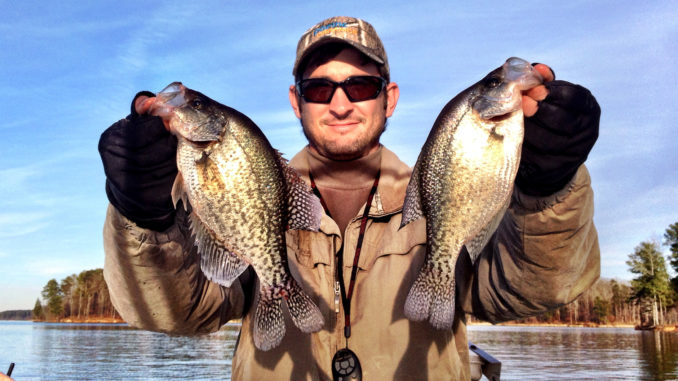
Slabs are shadowing threadfin shad movements; main-lake points have been productive
With water temperatures dipping into the 40s, the crappie in Shearon Harris Lake are going deep, seeking stable conditions and a steady supply of threadfin shad, according to Greg Griffin of Greggofish Guide Service.
“I usually have about two months of easy fishing, from now until around the first of March,” said Griffin, who targets the favored panfish in 25 to 32 feet of water.
“The fish may be scattered, but they’re in specific areas,” he said, noting that main-lake points south of the Holleman’s Crossing boat ramp are good places to start.
Griffin’s first step is to locate the bait on his depth finder, then find the crappie underneath.
“They’re going to be where the shad are. They won’t relate to any structure this time of year; they follow the bait,” he said.
Once he’s got his quarry in his crosshairs, Griffin (919-434-4183) lowers to the correct depth a Carolina rig and small, live minnows.
“I use a 20- to 24-inch section of monofilament leader and a No. 4 light wire hook,” he said. “Let the weight hit the bottom and reel up twice. That should leave the minnow about eight inches off the bottom. That’s where they’re going to be in the winter pattern; I put my slip floats away.
“I’ll either use the trolling motor or drift with the wind when I find them; I don’t like to sit still. You may find a concentration of fish here or there, but to catch good numbers, you’ll have to be moving,” Griffin said. “Top speed for this operation is around a half-mile an hour. Sinkers of up to ¾-ounce may be used to keep the rig vertical.”
When Griffin finds himself over tight-lipped fish, he pulls a winner out of his bag of tricks.
“If I can see fish on my sonar unit but they won’t eat, I’ll let the sinker hit the bottom and raise the rod tip slowly, about two feet up and down, until they bite. That has saved a lot of trips for me,” he said.
Although the action may not be as fast and furious as a spring bite, Griffin said it’s one of the most consistent.
“I don’t have a lot of bad days in the winter; some are better than others, but the pattern is predictable. The fish are deep, and that’s where they stay until the water warms up,” he said.




Be the first to comment